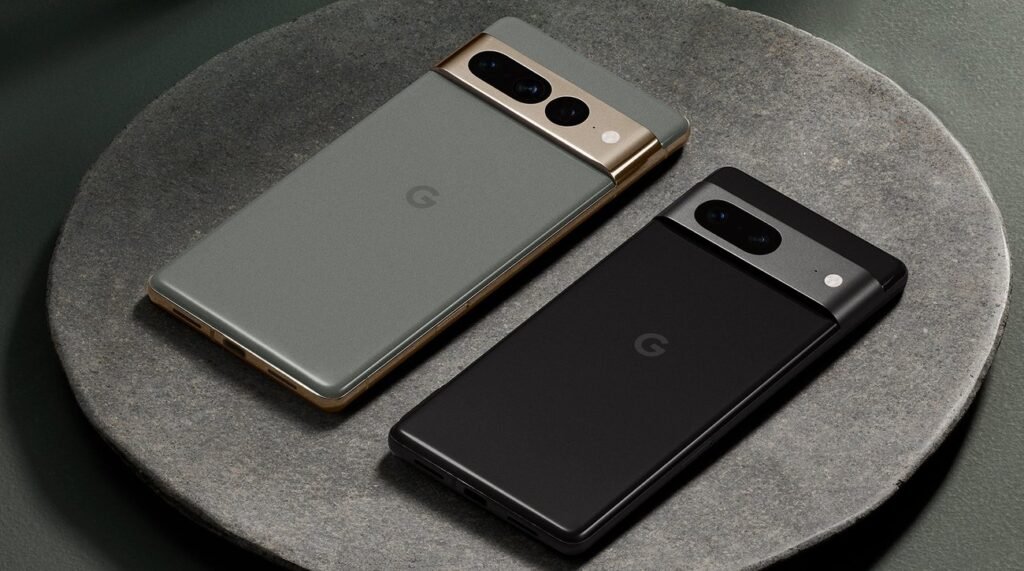Building on the bold redesign and the introduction of the Tensor chip with the Pixel 6 series, Google launched the Pixel 7 and Pixel 7 Pro in October 2022. This generation wasn’t about revolution but evolution. Google focused on refining the hardware, enhancing the custom processor for even smarter AI features, improving usability, and polishing the overall experience.
Design: Polishing the Camera Bar

The distinctive look of the Pixel 6 returned, but with elegant refinements:
- Metallic Camera Bar: The signature Camera Bar remained but was upgraded. It was now crafted mostly from aluminum (matte finish on the Pixel 7, polished on the 7 Pro), seamlessly blending into the phone’s frame for a more integrated and premium look. Distinct “pill” and “circle” cutouts housed the camera lenses within the bar.
- Subtle Size Tweaks: Both models were slightly more compact and lighter than their Pixel 6 counterparts, improving handling.
- Premium Build: Gorilla Glass Victus continued to protect the front and back, paired with the aluminum frame and IP68 water/dust resistance.
- Biometrics Enhanced: The under-display optical fingerprint sensor returned, with improvements generally making it faster and more reliable than the sometimes-finicky sensor on the Pixel 6 at launch. Crucially, Google also added camera-based Face Unlock for convenient screen unlocking (though it wasn’t secure enough for payments or app logins like the fingerprint sensor).
- Colors: The Pixel 7 came in Obsidian (black), Snow (white), and Lemongrass (a pale yellow-green), while the 7 Pro offered Obsidian, Snow, and Hazel (a greyish-green with gold accents). The headphone jack remained absent.
Hardware: Tensor G2 Takes the Helm
The core hardware saw targeted upgrades:
- Google Tensor G2: The second generation of Google’s custom chip arrived. While raw CPU performance saw only modest gains (updated mid-cores, slightly faster clock speeds), Tensor G2 focused on efficiency and significantly boosting AI and ML performance thanks to an upgraded Tensor Processing Unit (TPU) – up to 60% faster for some tasks. It also featured an upgraded GPU (Mali-G710 MP7) and the integrated Titan M2 security chip.
- RAM & Storage: Configurations remained the same: 8GB RAM for Pixel 7, 12GB for Pixel 7 Pro, paired with fast UFS 3.1 storage (128/256GB options for both, plus 512GB for the Pro).
- Brighter Displays: Both OLED displays received brightness boosts compared to the Pixel 6 series. The Pixel 7 featured a 6.3-inch FHD+ 90Hz flat display, while the 7 Pro sported the top-tier 6.7-inch QHD+ 10-120Hz variable refresh rate LTPO curved display.
- Battery & Charging: Battery capacities were slightly reduced (4355mAh for Pixel 7, 5000mAh for 7 Pro), but efficiency improvements in Tensor G2 aimed to deliver comparable or better battery life. Charging speeds remained similar to the Pixel 6 (~21-23W wired peak, wireless, and reverse wireless charging).
Cameras: Enhanced Versatility and Unblurring the Past
While using similar main sensors, the Pixel 7 series cameras gained new capabilities, especially on the Pro model:
- Pixel 7: Kept the excellent 50MP main camera and upgraded the 12MP ultrawide with a slightly wider field of view (114°).
- Pixel 7 Pro: Featured the same 50MP main sensor, an even wider 12MP ultrawide (125.8°) with autofocus enabling Macro Focus for stunning close-up shots, and an upgraded 48MP telephoto lens with 5x optical zoom (up from 4x on the 6 Pro).
- Tensor G2 Camera Magic: The new chip powered impressive features:
- Photo Unblur: A standout feature in Google Photos (exclusive to Pixel 7 series at launch) that could sharpen any blurry photo, old or new, regardless of which camera took it.
- Faster Night Sight: Processing times for low-light shots were noticeably reduced.
- Enhanced Super Res Zoom: Improved digital zoom quality, reaching up to 8x on the Pixel 7 and an impressive 30x on the Pixel 7 Pro thanks to the longer optical zoom.
- Cinematic Blur: Added a portrait mode-like shallow depth-of-field effect to videos.
- Continued excellence with Real Tone, Magic Eraser, and Motion Mode. Support for 10-bit HDR video was also added.
- Front Camera: Both models used an upgraded 10.8MP ultrawide front camera.
Software: Android 13 Smarts
Launching with the refined Android 13 operating system, the Pixel 7 series built upon the Material You foundation and added more helpful AI features:
- Clear Calling: Reduced background noise for the person on the other end of your call.
- VPN by Google One: Initially offered as a free built-in perk for enhanced security (later became part of the Google One subscription).
- Continued Exclusives: Features like Recorder’s transcription, Call Screen, and Hold For Me remained key advantages.
- Update Promise: Google maintained its commitment of 3 years of OS updates and 5 years of security updates.
Reception and Legacy: Polished Excellence
The Pixel 7 and 7 Pro received highly positive reviews, widely regarded as smart, polished refinements of the Pixel 6 lineup. The improved design, brighter screens, more reliable fingerprint sensor, the convenience of Face Unlock, and especially the new camera features like Photo Unblur, Macro Focus, and enhanced zoom were lauded. Google’s software experience remained a highlight, and the phones continued to offer excellent value at their respective price points ($599/$899).
Criticisms were generally minor, often pointing to the iterative nature of the Tensor G2’s raw performance boost and charging speeds that still lagged behind some competitors. Overall, the Pixel 7 series successfully addressed many of the minor complaints about the Pixel 6, solidifying Google’s position as a maker of intelligent, capable, and desirable flagship smartphones.
